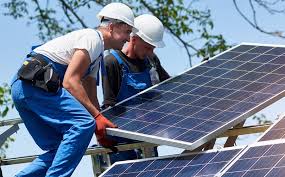Britain’s solar installers are busier than for nearly a decade, boosting the nation’s PV capacity by 5.3% in the past twelve months to 14.9GWp across over 1.3 million sites, overwhelmingly homes.
Nearly 19,500 installations were made last month, or 83MW new capacity, according to early government figures. Almost 17,000 went on homes.
Monthly installations have averaged 13,000 since March 2022, four times their rate during lockdown. In 2023, that rate has quickened, to 50,000 installations in the first quarter.
Heavy demand for solar has prompted the boss of Good Energy, Britain’s biggest voluntary administrator of the legacy Feed-in Tariff, to declare the end of the ‘solar coaster’, whose peaks and troughs dogged the industry in the 20teens.
Nigel Pocklington, CEO said ““We expect the surge in solar to continue for the foreseeable future and we plan to play a big part in helping customers benefit from it.”
After eight years, the FiT closed to new entrants in March 2019. Registrants continue for up to twenty years to receive inflation-linked payouts rewarding their generation.
“Previous peaks and troughs were driven by changes in government pay-outs on offer”, the Good Energy boss observed.
“The difference now is that people are highly worried about their energy bills, driven even higher by the war in Ukraine, and they are more concerned than ever about their environmental impact”.
In December the twenty year old Good Energy made its debut in fixing home PV systems, buying Igloo Works.
Solar installation, dominated by small companies, is at the heart of the green skills revolution otherwise lacking in technologies such as heat pumps.
D-ESNZ reports that at the end of 2022, 54% of solar capacity came from standalone and ground-mounted farms. The 7,739MW included two, Charity and Triangle, the first pair to be accredited under the expanded Contract for Difference regime.
Research from Good Energy’s EV charging partner ZapMap indicates that EV drivers are seven times more likely than average to have solar installed at home. The firm’s survey showed 29 per cent of ZapMap subscribers have PV at home.
Pocklington continued: “Good Energy has more generator customers than supply, and we paid out a record amount to renewable generators last year.
“With installations of clean energy technology such as solar panels set to be a significant growth market for many years, it is a key part of our strategy to become a leader in green energy services”.





Solar energy capture is a key element to building our source of fossil free energy, but connecting the new PV farms to the grid is problematic as the grid does not have the capacity to handle the additional electric power with many projects having to wait for years for a connection. Using the solar electricity where it is produced is key, especially from private houses that could also have their own EVs that could use it, which also underlines the importance of battery storage of fossil free electricity, whether at a wind farm or solar array, or just on the roof of a private house. As the UK Government’s hydrogen strategy published in august 2021 predicts that by 2050 around 30% of the UK’s primary energy will be delivered as hydrogen, producing it where the electricity is produced will help to relieve the load on the electric grid.